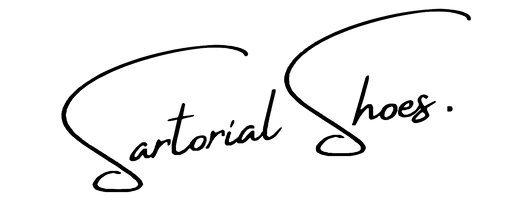Have you ever wondered where chukka boots get their name? Or when to wear loafers? If you have questions about any of the most iconic types of men’s leather shoes, you’ll probably find the answer in this article. It’s our ultimate guide, covering lace-ups and slip-ons, buckles and boots, all in an easy-reference format.
Oxfords
Oxfords are distinguished by their “closed lacing” system. That’s where the eyelet tabs are stitched beneath the vamp (the front part of the shoe between the heel and toe). The leather gap between the tabs appears to come to a point, with the toe and vamp forming a smooth, seamless join. They are named after Oxford University, where they became popular in the 1800s, evolving from the more restrictive Balmorals worn by students. However, they are sometimes still called Balmorals today, especially in the USA.
When to wear: Formal occasions, business meetings, weddings and black-tie events.
Pair with: Business suits, formal attire and tuxedos.
Derbies
At first glance, Derbies might look like Oxfords, but look closely and you’ll see they have “open lacing”, where the eyelet tabs are stitched on top of the vamp, forming visible flaps. This creates a slightly more casual look, as it’s less streamlined. Derbies can provide a more comfortable fit for men with high insteps (the top part of the foot), as they can be worn more loosely.
Derbies were originally designed as a sporting and hunting boot in the 1850s. Some people believe they’re named after the 14th Earl of Derby, who commissioned the style to accommodate his large feet (although this story is a little contentious).
When to wear: Business casual and smart casual occasions, and less formal workplaces.
Pair with: Tailored trousers, chinos, dark jeans and business casual attire.
Brogues
Technically, “broguing” is a technique and decorative style, not a shoe type. They can be Oxfords, Derbies or even boots. “Brogues” are the perforations that are punched through the shoe’s visible faces, with varying degrees of density, and with a range of patterns. However, the word is commonly used to describe the shoes themselves – i.e., a pair of brogues. They were originally developed in Scotland and Ireland, and the perforations were functional, designed to allow water to drain when crossing wet terrain, and to make shoes more breathable.
When to wear: Business casual to smart casual settings (the more broguing, the more casual the shoe).
Pair with: Tweed suits, blazers with chinos, and country attire.
Loafers
Loafers are slip-on shoes without laces, and offer convenience and comfort without sacrificing style. There are three main variants: penny, tassel and snaffle bit.
Penny loafers
Penny loafers feature a leather strap across the top, originally with a diamond-shaped cutout. The name came from the 1930s practice of students inserting a penny into the shoe’s slot for emergency phone calls. The slot can take many decorative forms other than diamonds.
When to wear: Business casual to smart casual occasions.
Pair with: Chinos, casual suits and even shorts in summer.
Tassel loafers
These slip-ons are distinguished by their decorative tassels on the front. The story goes that they were created in the 1950s when Hungarian actor Paul Lukas asked for tassels to be added to his shoes. The style caught on and they remain worn today – although it’s not clear why they’re not called Lukas loafers.
When to wear: Smart casual events, summer social gatherings.
Pair with: Navy blazers, summer suits and chinos.
Snaffle bit (horsebit) loafers

Gucci popularised this style in the 1960s, and they naturally became a symbol of Italian luxury. They feature a metal horse bit across the front.
When to wear: Smart casual to semi-formal occasions.
Pair with: Well-fitted trousers, casual suits and even dark jeans.
Monk straps
Recognisable by their buckle closures instead of laces, monk straps straddle the formal and casual boundaries. They are derived from shoes worn by European monks in the 15th century, who needed a protective but easy-to-remove shoe. They come in single and double straps, with the double being a more modern interpretation. There are also monk boots, which follow the same concept but with higher ankles.
When to wear: Business settings, semi-formal occasions.
Pair with: Business suits, separates and smart casual attire.
Boots
Although boots are generally a more rugged shoe to wear in the wet and the cold, they can also be incredibly refined and businesslike. The style you choose is up to you, but the lighter styles with less prominent soles work best with suits, while chunkier boots can look great with jeans and chinos.
Chelsea boots
Chelsea boots are ankle-high boots that have elastic side panels to help get them on and off, but they have no laces or buckles. They can date their history back to Victorian times, but they got a fashion boost in the 1960s when they were worn by John, Paul, George and Ringo.
When to wear: Casual to smart casual settings, especially in autumn and winter.
Pair with: Jeans, chinos and casual suits.
Chukka boots
Slightly more formal in nature, chukka boots are ankle-high lace-up boots with several eyelets. The name comes from polo players’ footwear in the 1940s. A “chukka” refers to a period of seven minutes in the game, a word that traces its roots back to India, where polo was immensely popular.
When to wear: Casual to business-casual environments.
Pair with: Chinos, jeans and casual trousers.
Check out our collection
Now you know what you’re looking for and how to wear your leather shoes, you’re hopefully better informed to make a choice. We’ve got all the styles and sub-styles of shoes, for business and pleasure, all designed with fashion and quality in every stitch.









